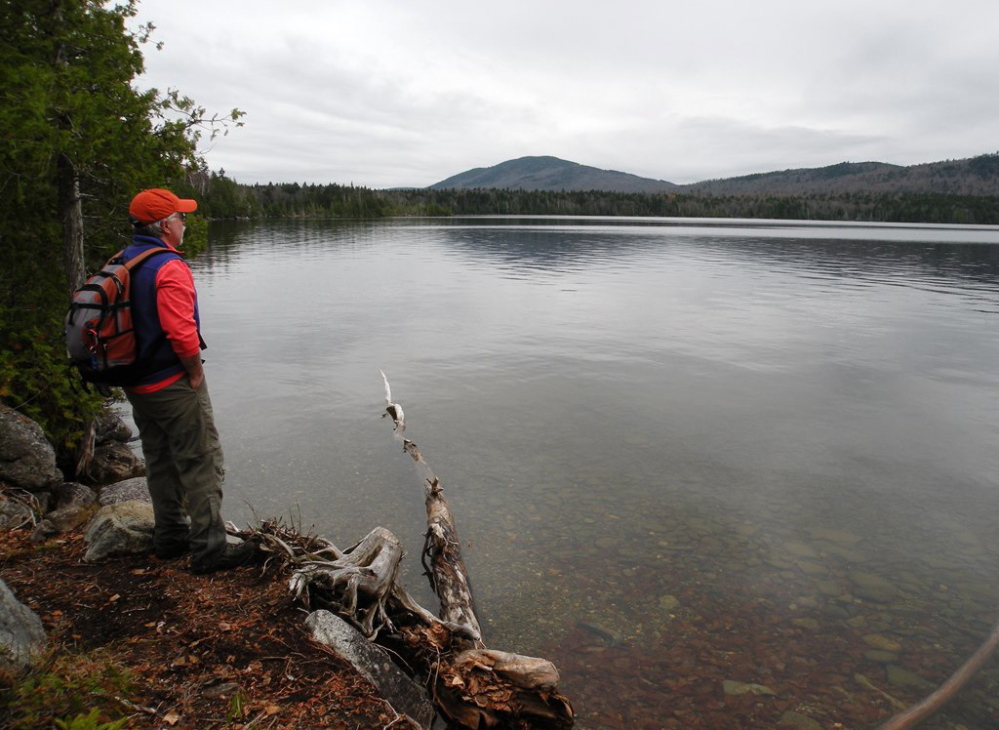In early October 1775, Gen. Benedict Arnold and a contingent of 1,100 American soldiers made the portage over the Great Carrying Place between the Kennebec River and the Dead River on their wilderness expedition to Quebec City. The lengthy and difficult portage greatly weakened Arnold’s army, which ultimately failed in its attempt to wrest control of the city from the British and thereby expand the Revolutionary War, forcing it to retreat in defeat in the dead of winter.
Hikers today can explore this incredible 13-mile segment of history thanks to the Arnold Expedition Historical Society, which recently opened the Great Carrying Place Portage Trail after seven years of hard work and 239 years after Arnold and his troops passed through.
“We wanted to recreate and reopen the route so modern people could get a sense of what the Arnold Expedition had to go through on their way to Canada,” said Stephen Clark, society member and author of a new guide that describes the portage trail. “It’s a way of expressing history by allowing us to walk in their footsteps.”
The new trail begins at Carrying Place Stream on the western shore of Wyman Lake, a 15-mile stretch of the Kennebec River impounded by Wyman Dam in 1930. The trail climbs 750 feet to East Carry Pond and then proceeds to Middle Carry Pond. Just beyond at Sandy Stream, the trail joins the Appalachian Trail and follows it for some three miles, crossing Arnold Bog and then traveling over a wooded ridge to reach West Carry Pond at Arnold Point. Ahead, the trail reaches its 1,519-foot high point just north of Roundtop Mountain before descending to cross Long Falls Dam Road on its way to Flagstaff Lake, which submerged the Dead River in 1950.
Hikers can walk the Great Carrying Place Portage Trail in short segments, make it a long day hike, or turn it into an overnight journey with a stay at the AT lean-to on West Carry Pond. Clark recommends hiking the trail from east to west “to more closely emulate the experiences of the soldiers of the 1775 expedition.”
The portage route over the Great Carrying Place was discovered and developed by Native Americans many centuries ago as a way to travel between the Maine coast and the St. Lawrence River, allowing them to bypass the dangerous rapids and falls on the Kennebec River above Caratunk.
Heavily burdened, “Arnold’s men had to make as many as six trips between each segment of the portage,” explained Clark. “That’s 31/2 miles each way between the Kennebec River and East Carry Pond times six for a total of over 40 miles.”
This grueling back and forth shuttling was then repeated between each of the three ponds en route before the Dead River was finally reached. Moving tons of heavy wooden boats (some 220 in all) and countless barrels of supplies and military equipment in this manner so depleted the troops that a small field hospital was hastily constructed near East Carry Pond to attend to the sick and disabled soldiers. It took Arnold’s army nearly two weeks to complete the portage, an amazing feat on its own.
This year the AEHS overcame two major obstacles that allowed final completion of the trail: The National Park Service granted permission to utilize a portion of the Appalachian Trail between Sandy Stream and West Carry Pond, and Plum Creek allowed a right-of-way around the south end of West Carry Pond. The trail was then blazed with orange paint and directional signs erected.
Hikers will want a copy of Clark’s trail booklet, available for $5. Another must-have is “Arnold’s Wilderness March,” a full-color map and guide ($6) to enjoying the 80-mile section of the expedition route between the Kennebec and Lac Megantic by car, canoe and foot. Get them both by writing to AEHS, 60 Burnham Road, Scarborough 04074. More info: arnoldsmarch.com.
Carey Kish of Southwest Harbor is editor of the AMC Maine Mountain Guide. Follow Kish’s adventures in his Maineiac Outdoors blog at:
mainetoday.com/blog/maineiac-outdoors.
Send questions/comments to the editors.



Success. Please wait for the page to reload. If the page does not reload within 5 seconds, please refresh the page.
Enter your email and password to access comments.
Hi, to comment on stories you must . This profile is in addition to your subscription and website login.
Already have a commenting profile? .
Invalid username/password.
Please check your email to confirm and complete your registration.
Only subscribers are eligible to post comments. Please subscribe or login first for digital access. Here’s why.
Use the form below to reset your password. When you've submitted your account email, we will send an email with a reset code.